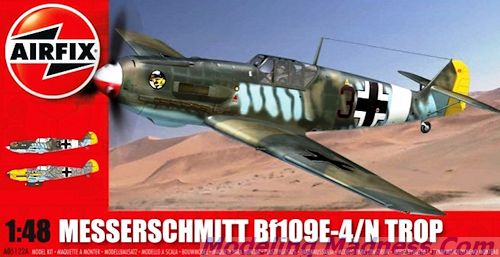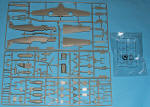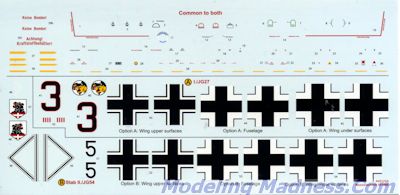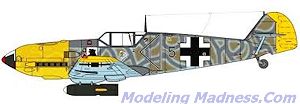
Airfix 1/48 Bf-109E-4/Ntrop
| KIT #: | A05122A |
| PRICE: | $25.98 MSRP |
| DECALS: | Two options |
| REVIEWER: | Scott Van Aken |
| NOTES: |

| HISTORY |
In late 1938, the "Emil" entered production. To improve on the performance afforded by the rather small 447-522 kW (600-700 hp) Jumo, the larger Daimler-Benz DB 601A engine was used, yielding an extra 223 kW (300 hp) at the cost of an additional 181 kg (400 lb). To test the new 1,100 PS (1,085 hp, 809 kW) DB601A engine, two more prototypes (V14 and V15) were built, each differing in their armament. While the V14 was armed with two 7.92 mm (.312 in) MG 17s above the engine and one 20 mm MG FF in each wing, the V15 was fitted with the two MG 17s mounted above the engine only. After test fights the V14 was considered more promising and a pre-production batch of 10 E-0 was ordered. Batches of both E-1 and E-3 variants were shipped to Spain for evaluation, and received their baptism of fire in the final phases of the Spanish Civil War.
E-4
The E-3 was replaced by the E-4 (with many early airframes being upgraded to E-4 standards starting at the beginning of the Battle of Britain) which was different in some small details, most notably by using the modified 20 mm MG-FF/M wing cannon and having improved head armor for the pilot. With the MG FF/M it was possible to fire a new and improved type of explosive shell, called Minengescho▀ (or 'mine-shell') which was made using drawn steel (the same way brass cartridges are made) instead of being cast as was the usual practice. This resulted in a shell with a thin but strong wall, which had a larger cavity in which to pack a much larger explosive charge than was otherwise possible. The new shell required modifications to the MG FF's mechanism due to the different recoil characteristics, hence the MG FF/M designation.
The cockpit canopy was also revised to an easier-to-produce, "squared-off" design, which also helped improve the pilot's field of view. This canopy, which was also retrofitted to many E-1s and E-3s, was largely unchanged until the introduction of a welded, heavy-framed canopy on the G series in the autumn of 1942. The E-4 would be the basis for all further Bf 109E developments. Some E-4 and later models received a further improved 1,175 PS (1,159 hp, 864 kW) DB601N high-altitude engine; known as the E-4/N this first appeared in July 1940. The E-4 was also available as a fighter-bomber with equipment very similar to the previous E-1/B. It was known as E-4/B (DB 601Aa engine) and E-4/BN (DB 601N engine). A total of 561 of all E-4 versions were built, including 250 E-4, 20 E-4/N, 211 E-4/B and 15 E-4/BN. Many E-4s were also retrofitted with plumbing to allow the use of a drop tank, something introduced in E-7 production in late 1940 and which would have been very useful during the Battle of Britain.
| THE KIT |
 This
is the fourth or fifth incarnation of Airfix's 1/48 Bf-109E. This time it is
being boxed as an E-4/N trop. In line with Hasegawa, this kit is nothing more or
less than a new decal sheet. At least that is how it looks to me. There sprues
are identical and it makes me wonder why the 'A' is in the kit number suffix.
That usually indicates some sort of improvement, but I don't see one; only a
different decal sheet. The prop is the same, the rudder appears the same, and
the landing gear legs look the same as well. Those are the areas I noticed that
needed improvement on the initial boxing I built.
This
is the fourth or fifth incarnation of Airfix's 1/48 Bf-109E. This time it is
being boxed as an E-4/N trop. In line with Hasegawa, this kit is nothing more or
less than a new decal sheet. At least that is how it looks to me. There sprues
are identical and it makes me wonder why the 'A' is in the kit number suffix.
That usually indicates some sort of improvement, but I don't see one; only a
different decal sheet. The prop is the same, the rudder appears the same, and
the landing gear legs look the same as well. Those are the areas I noticed that
needed improvement on the initial boxing I built.
As a recap, let's start with the detailing. What seems to be a bit overdone in 1/72 scale, seems just about right in 1/48. It is still not as petite as what you find on Hasegawa kits and is nearly the same as on Tamiya kits. The plastic has a somewhat matte finish and thanks to good quality control, there are no sink areas near the alignment pins, a real problem with some kits. There are a few inserts to take care of the different variants, specifically the gun position on the wing leading edge where the position of the gun is different on the E-1 as compared to the cannon armed E-3/4/7 versions.
The cockpit is very nicely done with all the various bits one would expect and that includes sidewall detailing and parts. The seat has a molded in seat harness and Airfix provides a very nicely done three piece pilot in appropriate garb. An engine half is molded into each fuselage half and there are engine mounts to add to the detail. Cementing the upper cowling is an option, though I think most will do just that. Unlike all of Airfix's competitors, all of the flight control surfaces are separate. This includes the leading edge slats. The flaps have tabs to be in the normal down position, but by removing them you can position them up. Rudder and elevators are also separate to allow them to be more dynamically positioned. Two different upper cowlings are provided. A sand filter is provided for the desert markings.
A 'wheels up' option is provided by doors with wheels halves attached. The kit main wheels are flattered and bulged a bit. The outer wheel hub is a separate item to assist in painting. For things under the fusealge, there are ooptions of a drop tank, 250 kg bomb, 500 kg bomb or a tray with four bombs (I'm guessing 50 or 100 kg). Several different windscreens and backlights are provided depending on which variant is being done. The windscreens include one with additional armor and one with a telescopic gunsight. The main canopy section is molded with tabs on it to pose it open, but one can cut those away for a closed cockpit. To my eye, the windscreens are not as nicely done as those on the Tamiya and Hasegawa kits, being a bit thick. Three different spinners are offered, one with the cannon opening and two pointed spinners; one more blunt than the other.
I know that people will or have picked this one apart already and I'll let them. The only real disconnect I could find is that there are no wing shell ejector chutes. There is an area to be opened if one is using the cannon wings (for the E-3/4 version). I don't recall if the 109E ejected shells or retained them in catch areas to be recycled. If not, one can duplicate these openings with little rectangles of black decal. I also noted that some parts not used may be applicable to an E-7 version. One has to realize that during the Battle of Britain and before, 109Es were not plumbed for drop tanks or even bombs (until late 1940). It was the 109E-7 that introduced the ability to carry a drop tank and of course, this and the bomb thing was retrofitted to the earlier versions.
 Instructions
are well done and the 43 construction steps are easy to follow. Airfix continues
their irritating habit of using Humbrol numbers for paints rather than telling
us what the shade actually is. The only place that is provided is in the full
color painting and markings guide. There are two decal options. One is the box
art plane of Edward Neuman of 1./JG 27 in North Africa during 1941/42. This has
the then-standard European scheme of RLM 71/02/65 with a yellow rudder and
Instructions
are well done and the 43 construction steps are easy to follow. Airfix continues
their irritating habit of using Humbrol numbers for paints rather than telling
us what the shade actually is. The only place that is provided is in the full
color painting and markings guide. There are two decal options. One is the box
art plane of Edward Neuman of 1./JG 27 in North Africa during 1941/42. This has
the then-standard European scheme of RLM 71/02/65 with a yellow rudder and
 white
fuselage band. The other is an E-7 variant flown by Stab II./JG 54 in Romania
during March of 1941. This aircraft has an interesting scheme with lots of
yellow on the nose, rudder, wing tips and the trailing edges of the upper wings
as well. The
decal sheet is well printed and includes full data markings, but no swastikas.
Time to break out the swastika sheets for this and other Airfix kits.
white
fuselage band. The other is an E-7 variant flown by Stab II./JG 54 in Romania
during March of 1941. This aircraft has an interesting scheme with lots of
yellow on the nose, rudder, wing tips and the trailing edges of the upper wings
as well. The
decal sheet is well printed and includes full data markings, but no swastikas.
Time to break out the swastika sheets for this and other Airfix kits.
| CONCLUSIONS |
While one cannot please everyone, I think that those who buy this kit will be pleased with what they are getting. It looks to be pretty accurate with enough detail and options to please most builders. It is also one of the better deals for the money we have had in kits in a long time. I built the initial release back about 4 years ago and while I used a bunch of Pavla aftermarket on it to see how it fit, found it to be a nice build.
| REFERENCES |
http://en.wikipedia.org/wiki/Messerschmitt_Bf_109_variants
September 2014
Thanks to me for buying this one so you can see what it is like.
If you would like your product reviewed fairly and quickly, please
contact
me or see other details in the
Note to
Contributors.